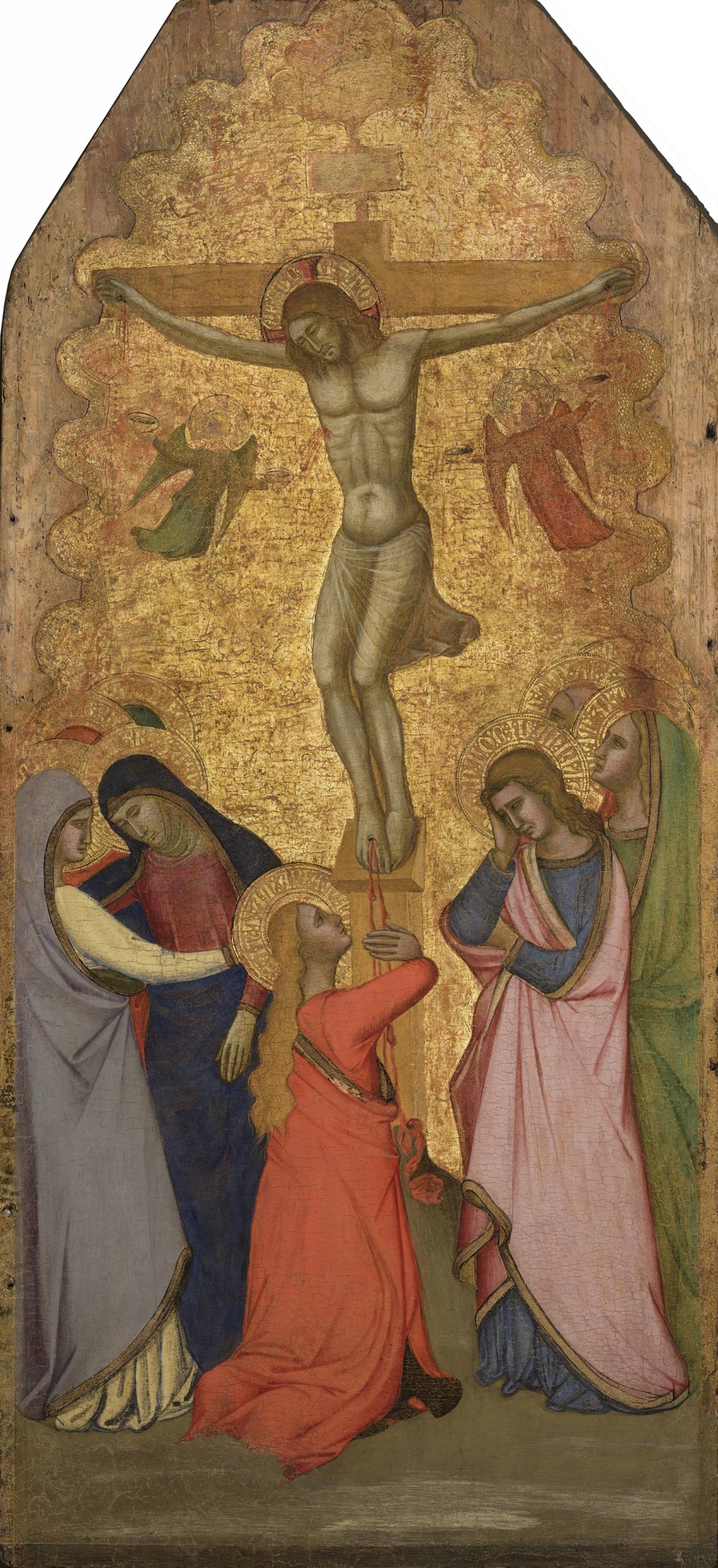Andrea Bonaiuti
(Recorded in Florence and Pisa from 1346 to 1379)
Crucifixion, c. 1360
tempera on panel, gold ground, 130 x 59,5 cm (51.18 x 23.43 inches)
Andrea Bonaiuti
(Recorded in Florence and Pisa from 1346 to 1379)
Crucifixion, c. 1360
tempera on panel, gold ground, 130 x 59,5 cm (51.18 x 23.43 inches)
Re: 841
Provenance: Udine cathedral (possibly)
A. Tartuferi, Andrea Bonaiuti, a Polyptych Reassembled, Florence, 2023
Provenance:
Udine cathedral (possibly)
Apostolat des Rédemptoristes, Namur, Belgium
Private collection, Belgium
The attribution of this hitherto wholly unknown painting to Bonaiuti is not in the least problematic for the expert because its stylistic features point extremely clearly and absolutely unmistakably to the hand of that Florentine master.
We can also state, with equal certainty, that the picture is the central panel of a polyptych whose side panels portraying St. Agnes, St. Bartholomew, St. Nicholas and St. Elisabeth of Hungary – first attributed to the painter by Richard Offner – joined the collection of the Museum of Fine Arts in Houston, Texas, in 1944 along with the rest of the collection of Edith A. and Percy St. Straus (1876 – 1945), to which they had belonged since at least the mid-1920s .
The Houston panels, which are unfortunately in very poor condition, had previously formed part of the collection of Osvald Sirén, a great expert in the field of early Florentine art, in Stockholm, and subsequently of the collections in London of A. Ruck and Edward Hutton, who sold them to Straus. In any event, the reconstruction of what was undoubtedly one of the most important altarpieces to have emerged from Bonaiuti’s workshop appears to be beyond question, both because the Crucifixion under examination matches the panels in the United States to a fault in stylistic and chronological terms, and because they share compatible dimensions, even allowing for the fact that all the pieces were shorn to a varying degree at one point or another in their history, most probably from the very moment the polyptych was separated from its original frame, which must have been complex in its structure judging by the paintings’ considerable size. And finally, unmistakable confirmation is provided by the absolutely identical nature of the singular punched decorative motif at the edges consisting of a series of protrusions which, in the central panel with the Crucifixion, continue around the edges on both sides right up to the foot of the cross. This unique motif occurs in absolutely identical form on the Houston panels, most clearly in the upper part of those with St. Bartholomew and St. Nicholas. It is also possible that the only known predella panels hitherto associated with Bonaiuti, each depicting a pair of saints in quatrefoil, once formed part of this altarpiece. The first two, now in the Museo Nazionale di San Matteo in Pisa, show St. Francis of Assisi and St. Louis of Toulouse, and St. Philip and St. Peter respectively, while the other two, now in the Pinacoteca Vaticana (inv. 115A-115) depict St. Augustine (?) and St. Julian in one and St. Paul and St. Michael the Archangel in the other .
Considering that the young Bonaiuti must have embarked on his career towards the middle of the century after surviving the Black Death of 1348, the most likely date for the Salamon-Houston polyptych, in my view, is the late 1350s, or c. 1360 at the latest. The polyptych constitutes a major addition to our knowledge of Bonaiuti and of Florentine painting in the second half of the 14th century in general. It appears to be the artist’s earliest work to have survived at least in part and it shows, well before his best-known and most important undertaking, the frescoes in the Cappellone degli Spagnuoli in Santa Maria Novella in Florence, that he was capable of handling the most prestigious commissions.

